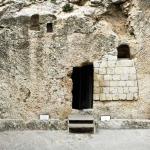JOEL’S QUESTION:
[Explanation:] The pastor of a New Jersey Protestant congregation sent in several “questions that have come up here.” One of them is how to understand the passage in the New Testament letter of 1st Peter about Jesus Christ preaching to “the spirits in prison.”
THE RELIGION GUY’S ANSWER:
The Bible’s major teachings are clear enough. But Joel and his parishioners shouldn’t be embarrassed if they’re confused about this particular New Testament head-scratcher. Even Martin Luther (who so energized Bible study 500 years ago by sparking the Protestant Reformation) said it’s “certainly a more obscure passage than any other in the New Testament. I still do now know for sure what the apostle means.” Robert Mounce, president of Whitworth University, agreed that this section is “widely recognized as perhaps the most difficult to understand in the New Testament.”
Here’s the text at issue: “Christ also died for sins once for all, the righteous for the unrighteous, that he might bring us to God, being put to death in the flesh but made alive in the spirit; in which he went and preached to the spirits in prison, who formerly did not obey, when God’s patience waited in the days of Noah . . .” (1 Peter 3:18-20a, RSV translation).
The following analysis relies especially on commentaries by Mounce, an American, the German exegete Leonhard Goppelt, and England’s J.N.D. Kelly. Scholars candidly admit that each explanation has problems. Among them:
- Between his death by crucifixion and bodily resurrection, Christ visited the realm of the dead and preached to Noah’s wicked contemporaries. That was the view of early church “Fathers,” notably Clement of Alexandria. Modern liberal Protestants like the suggestion that sinners in the hereafter might get a “second chance” through Christ preaching salvation. Conservatives think Christ more likely would preach victory and judgment over evil, and they reject any second-chance theory due to New Testament verses like Luke 16:26 and Hebrews 9:27.
- The pre-existent, heavenly Christ, prior to his incarnation on earth, preached through Noah as his spokesman to a generation that rabbinical tradition viewed as the epitome of evil, caught in the “prison” of their sin. That was taught by the influential St. Augustine, followed by many other Catholics and some Protestant Reformers.
- Between his crucifixion and resurrection, Christ visited fallen angels held in some sort of imprisonment. Due to the Noah reference they were probably the “sons of God” who took human women in the era before Noah’s Flood (Genesis 6:1-4, another difficult passage). This could link with the New Testament’s teaching that “the angels that did not keep their own position but left their proper dwelling have been kept by him in eternal chains in the nether gloom until the judgment of the great day . . .” (Jude 6).
- After Pentecost and the birth of the Christian church, the spirit of Christ preached, through the apostles, to people imprisoned in sin and ignorance. This heavily symbolic interpretation has little scholarly support.
- Ancient scribes mistakenly dropped the name of Enoch as the preacher in prison when they copied the biblical text. However, there’s no manuscript evidence for this long-ago guess by Anglo-American Quaker J. Rendel Harris that has no advocates today.
Either option 1 or 3 could relate 1 Peter to Ephesians 4:9 (Jesus “descended into the lower parts of the earth”) and the familiar phrase in the later Apostles’ Creed that after the crucifixion Jesus “descended to hell.” For more about that creedal statement see “Religion Q & A” for November 8, 2014: www.patheos.com/blogs/religionqanda/2014/11/why-does-the-creed-say-jesus-descended-into-hell
Goppelt thought there was much to be said in favor of option 1, in part due to its embrace early in church history. In his optimistic reading, the 1 Peter passage declares that “even to this most lost part of humanity, Christ, the One who died and rose, offers salvation.”
According to Kelly, there was a “growing conviction among scholars” that the fallen angels of option 3 offered the only way to clear up the passage’s “obscurity.” His intricate word-by-word analysis said these verses echoed 1 Enoch, a non-biblical Jewish writing thought to have influenced New Testament writers. Unlike Goppelt, Kelly thought Christ would not have preached salvation and conversion but a “triumphant announcement” that apostates are doomed, which would have provided great comfort to oppressed Christians in the 1st Century.
Mounce also favored a fallen angels scenario, but not the unholy alliance with earthly women in Genesis 6. Instead, he identified 1 Peter’s spirits in prison with the sinful angels of 2 Peter 2:4 who were cast into hell and “pits of nether gloom to be kept until the judgment.” Like Kelly, he thought Christ’s preaching brought no “second chance” at salvation but announced “the complete and final victory over the power of sin and Satan” through his death and resurrection.
As is often the case with “Religion Q & A,” The Guy has surveyed the state of the question and what experts tell us, rather than proposing (or imposing) his own answer. That’s usually appropriate for a non-partisan journalist treating such matters of interpretation, as opposed to established fact. Humility certainly befits a biblical passage that left the likes of Luther uncertain.










